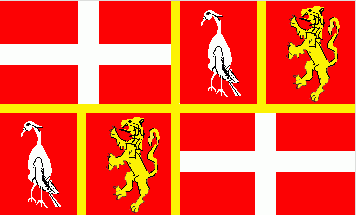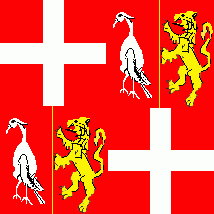 image
by Klaus-Michael Schneider, 21 October 2008
image
by Klaus-Michael Schneider, 21 October 2008
Last modified: 2013-06-29 by rob raeside
Keywords: sovereign and military order of malta | de la vallette | vallette | grandmaster |
Links: FOTW homepage |
search |
disclaimer and copyright |
write us |
mirrors
 image
by Klaus-Michael Schneider, 21 October 2008
image
by Klaus-Michael Schneider, 21 October 2008See also:
Flag of Grandmaster Jean Parisot de la Vallette (1557-1568) (square)
It is
a quarterly divided square flag. The 1st and 4th quarter are showing the white
Greek cross in a red field of the Order of St. John. The 2nd and 3rd quarter are
showing the personal arms of the grandmaster. The red field is divided by a
golden (= yellow) pale. On the dexter side is a silver (= white) rampant crane,
on the sinister side a golden red armed and tongued rampant lion. (This lion is
also depicted upon the flag of the city of Valletta).
Source: The artist Mateo PEREZ de ALECCIO created a series of paintings, describing the great siege of 1565. Among those is one, showing the Turkish siege of Fort St. Michael on 25 June 1565. This image you can see e.g. in Joseph ELLUL: “1565 - Die große Belagerung von Malta”; p.40. A better image is depicted in MERIAN, (German monthly), no. 47/1; p.105. There are many cross-flags of the order, the biggest of all upon Fort St. Angelo and a tiny one, showing the arms of La Valette, right in the middle of Birgu city, in the quarter of the auberges, north of nowadays Victory Square.
Klaus-Michael Schneider, 21 October 2008
 image
by Klaus-Michael Schneider, 21 October 2008
image
by Klaus-Michael Schneider, 21 October 2008
Flag of Grandmaster Jean Parisot de la Vallette (1557-1568) (rectangular)
It is a quarterly divided rectangular flag with ratio estimated 3:5. All the
quarters are divided by thin yellow lines from one another. The images upon the
quarters are the same like those of the square flag.
Source:
I spotted
this flag on 21 September, the independence day of Malta in Republic Street.
First I thought, it was the city flag of Valletta. Later I realized, that
this flag showed the arms of J.P. de la Vallette. May be that this flag today
is used as flag of the “Soz.Fil.Naz. La Valette A.D.1874”. It was hoisted in
front of the societies building.
Klaus-Michael Schneider, 21 October 2008
The flag of Malta's capital city, Valletta is not
identical to the arms of its namesake, Grand Master Jean Parisot de la Vallette
(reigned 1557-1568), but to the "sinister" half of his arms ("Per pale Gules a
falcon Or and Gules a lion Or")
http://www.smom-za.org/smom/grandmasters/49.htm:
According to that
webpage:
"Jean Parisot de la Vallette, a Knight of the "Langue" of Provence,
was proclaimed Grandmaster on 21st August 1557. La Vallette, however, had other
more threatening problems to attend to. Tripoli was one of these: It had been
reconquered by the Turks and was governed by the Turkish General, Dragut. On
18th May 1565 some 138 galleys under the command of Piali' Pasha and carrying a
landing force of 40,000 men commanded by Mustapha Pasha appeared off Malta's
coasts and started the Great Siege of 1565. Almost four months later, on 6th
September, the defeated Turkish armada left these shores. The heroic Grand
Master died on 21st August 1568. He was buried in the church of Our Lady of
Victories (where the foundation stone of Valletta (Malta's capital city) was
laid in 1566 by La Vallette himself)."
A present-day representation of
Grand Master la Vallette's standard can be seen here:
http://www.heraldica.org/topics/national/malta2.htm, though the falcon is
shown Argent ...and looks rather like a crane.
According to this
webpage:
http://www.jkproperties.com.mt/poi.html,
"Valletta, the capital was
built by Jean de la Valette, French Grand Master of the Order of the Knights of
St. John of Jerusalem, after the epic siege of 1565. It dominates the island’s
historic Grand Harbour — one of the finest natural ports in Europe. Within its
limited boundaries is reflected some of Malta’s rich heritage of archaeology,
history, architecture, art and culture. On the arrival of the Knights 1530
Valetta was still a rocky hill called Xibberras and Vittoriosa was the centre
of all harbour activities.
"It was the magnificence of its palaces and
other treasures that led Sir Walter Scott to describe Valletta as The city
built by gentlemen for gentlemen. Valletta, Malta’s capital, is a 16th-century
rarity that has changed little over the centuries. It was planned for military
purposes and its walls are also bastions and fortifications. Valletta is also
packed with churches and palaces. There is no city quite like it in the world.
The knights used to the call it ‘the humble city’ and the Maltese call it
‘Il-Belt’.
"The foundation stone contained this inscription in Latin: “Fra
Jean De La Vallette, Grand Master of the Hospitaller Order of Jerusalem,
mindful of the danger of which, a year before, his Knights and the Maltese
people were exposed during the siege by the Turks, having consulted the heads
of the Order about the construction of a new city and the fortifying of the
same by walls, ramparts and towers sufficient to resist or to repel or, at
least, to withstand the Turkish enemy, on Thursday the 28 March 1566, [...]
laid the foundation stone of the city on the hill called Sceberras by the
natives, and having granted for its arms a golden lion on a red shield wishes
it to be called by his name, Valletta.”
"Five years later, the city was
complete — planned by an Italian military engineer, Francesco Laparelli, a
colleague of Michelangelo; built in the main by his assistant, Maltese
architect Gerolamo Cassar; and named for the Grand Master of the Knights of St.
John who initiated the plan, Jean Parisot de la Vallette."
Santiago
Dotor, 15 March 2006